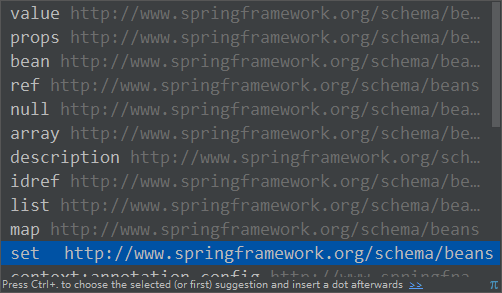¶spring
¶resource资源接口
1 | //只用管三个实现 ClassPathResource FileSystemResource ServletContextResource |
- ant风格,使用ResourceLoader子类才使用的
- *匹配任意字符
- **匹配多个路径
- ?匹配一个字符
1 | /** |
| 前缀 | 实例 | 对应资源 |
|---|---|---|
| classpath: | classpath:test.xml | classpath路径 |
| file: | file:d:/1.txt | 系统文件,可以使用相对路径 |
| http:// | http://localhost:8080/test.xml | url |
| ftp:// | … | ftp服务器 |
| 无前缀 | com/smart/xx.xml |
¶IOC
¶BeanFactory体系
¶工厂模式
简单来说工厂模式就是通过特定的工厂类来创建对象,bean工厂可以理解为对所有bean进行创建的类,工厂模式可见设计模式部分.
1 | public void beanFactoryTest(){ |
¶BeanFactory和Context的关联
- 从关系上看是包含关系
¶IOC中各种处理器
- aware接口 | BeanPostProcessor 接口 | init |des
- InstantiationAwareBeanPostProcessor 该接口实际是BeanPostProcessor的子类
BeanFactory会在添加BeanPost的时候对InstantiationAwareBeanPostProcessor和DestructionAwareBeanPostProcessor做一个标记,供创建bean的时候使用
之所以其这个名字,是因为该处理器会在bean构造前后调用
1 | //在bean实例化之前调用,若该函数返回非null,则表示该bean实例化结束,不进行后续处理 |
- DestructionAwareBeanPostProcessor
¶IOC特性
¶定义
- 标签:bean:name:和id的区别是前者可以随意命名,后者要遵循规范
1
2
3<bean id="car" class="ioc.xml.Car"
name="./12car" scope="prototype"
/> //定义一个bean
¶属性
-
标签: P 或者property
-
通过set方法注入,value表示属性名,value表示直接值,ref表示引用其他bean
1
2
3
4
5
6
7<!--set赋值-->
<bean id="ref" class="ioc.xml.Ref"/>
<bean id="car" class="ioc.xml.Car" >
<property name="name" value="123"/>
<property name="count" value="22"/>
<property name="ref" ref="ref"/>
</bean> -
通过构造器,构造器分别可以通过参数名,参数位置,参数类型进行设值并构造对象
1
2
3
4
5<bean id="car2" class="ioc.xml.Car">
<constructor-arg name="name" value="car2"/>
<constructor-arg index="1" value="10"/>
<constructor-arg type="ioc.xml.Ref" ref="ref"/>
</bean>
¶工厂对象
- 标签: factory-method |factory-bean | FactoryBean接口
1
2
3
4
5
6
7
8
9<!--工厂构建-->
<!--非静态工厂-->
<bean id="factory" class="ioc.xml.CarFactory" p:name="car3" p:count="12" p:ref-ref="ref"/>
<bean id="car3" factory-bean="factory" factory-method="factoryCar"/>
<!--静态工厂-->
<bean id="car4" class="ioc.xml.CarFactory" factory-method="staticFactoryCar"/>
<!--实现BeanFactory的泛型工厂-->
<bean id="car5" class="ioc.xml.MyBeanFactory"/>
- 关于工厂模式,我们可以在要通过spring某些本身就是工厂模式的类的情况下使用
- FactoryBean接口是spring提供的接口,实现该接口的类用于创建bean,通过带有&前缀获取bean可以获取到该实例本身
¶注值protype使用
-
字面量:即prototype中使用value,当出现特殊需要转义的字符如
<使用<,或者使用<![CDATA[数据]]>来填写 -
引用:通过ref来引用其他bean,如果使用p标签则无法指定parent,用来引用父Context中的bean
1
2
3
4
5
6
7
8
9//pSpring.xml
<bean id="p" class="ioc.xml.Ref"></bean>
//xmlSpring.xml
<bean id="car6" class="ioc.xml.Car">
<property name="ref">
<ref parent="p"></ref>
</property>
</bean>
//可以引用父Context中的bean -
内部bean:类似于匿名bean,这种bean不能被别人引用
1
2
3
4
5
6<!--内部bean-->
<bean id="car7" class="ioc.xml.Car" p:name="car7">
<property name="ref">
<bean class="ioc.xml.Ref"></bean>
</property>
</bean> -
null值,通过
标签 1
2
3
4
5
6<!--null值-->
<bean id="car8" class="ioc.xml.Car" p:name="car8">
<property name="ref">
<null></null>
</property>
</bean> -
级联:即可以对bean内部某个域的属性进行赋值,前提是该域被创建,可以多级级联
1
2
3
4
5
6<!--级联-->
<bean id="car9" class="ioc.xml.Car" p:name="car9">
<property name="cascade.a" value="12"/>
</bean>
//car
private Cascade cascade=new Cascade(); -
集合类属性
- List和set:list属性的值可以为匿名bean,引用bean,或者字面量,Set类型类似
- Map和properties,稍微注意一下语法就好了
- 集合支持通过merger属性和指定了parent的bean进行属性合并
- value-type,可以指定当前集合类型,实际不指定也没有问题,仅仅区别在于spring源码类型转换过程
1
2
3
4
5
6
7
8
9
10
11
12
13
14
15
16
17
18
19
20
21
22
23
24
25
26
27
28
29<bean id="ref" class="ioc.xml.Ref"/>
<bean id="col" class="ioc.xml.CollectionIoc">
<!--list-->
<property name="list">
<list>
<bean class="ioc.xml.Ref"></bean>
<ref bean="ref"></ref>
</list>
</property>
<!--map-->
<property name="map">
<map>
<entry key="1" value-ref="ref"></entry>
<entry>
<key>
<value>1</value>
</key>
<bean class="ioc.xml.Ref"></bean>
</entry>
</map>
</property>
<!--properties-->
<property name="properties">
<props>
<prop key="1">ceshi</prop>
</props>
</property>
</bean>
-
集合bean
通过util标签可以配置集合类型的bean
1
2
3
4
5<util:set id="setBean" set-class="java.util.HashSet">
<ref bean="ref"></ref>
</util:set>

这个图中说明的是作为属性的标签,在能够填入属性的位置就这些,再加上entery,配合spring语法很好理解
¶自动装配
autowire= byName byType constructor autodetect,这是xml配置的属性和注解配置是两个方式
1
2<!--自动装配-->
<bean id="car10" class="ioc.xml.Car" autowire="byName"></bean>
¶方法注入
通过CGlib进行方法增强来完成注入
- lookup:用来解决单例中每次调用获取新的域
1 | <bean id="ref2" class="ioc.xml.Ref" scope="prototype"/> |
¶bean之间的关系
- 父子继承|依赖|引用
1
2
3
4
5
6<!--bean关系-->
<!--继承-->
<bean id="carP" class="ioc.xml.Car" abstract="true" p:count="10" p:ref-ref="ref"/>
<bean id="car13" class="ioc.xml.Car" parent="carP" p:name="car13"/>
<!--依赖-->
<bean id="car14" class="ioc.xml.Car" depends-on="car13"/>
¶补充
- idref:充当bean的String属性,表示其他bean的id,如果不存在该id,则getBean过程抛出异常
1
2
3
4
5
6
7<bean id="teacher" class="test.teacher"/>
<bean id="student" class="test.teacher" >
<!--teacherId属性为String类型-->
<property name="teacherId">
<idRef bean="tacher">
<property>
</bean>
本博客所有文章除特别声明外,均采用 CC BY-NC-SA 4.0 许可协议。转载请注明来自 博客!
评论


